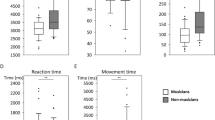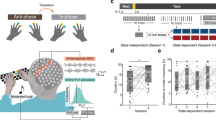Abstract
Functional reorganization in a musician’s brain has long been considered strong evidence of experience-dependent neuroplasticity. Highly coordinated bimanual movements require abundant communication between bilateral hemispheres. Interhemispheric inhibition (IHI) is the communication between bilateral primary motor cortices, and there is beginning evidence to suggest that IHI is modified according to instrument type, possibly due to instrument-dependent motor training. However, it is unknown whether IHI adaptations are associated with non-musical bimanual tasks that resemble specific musical instruments. Therefore, we aimed to investigate the relationship between IHI and bimanual coordination in keyboard players compared with string players. Bimanual coordination was measured by a force tracking task, categorized as symmetric and asymmetric conditions. Ipsilateral silent period (iSP) was obtained using transcranial magnetic stimulation to index IHI in both left (L) and right (R) hemispheres. Canonical correlation analysis was performed to identify linear relationships between the IHI and bimanual coordination outcomes. There was no difference in bimanual coordination outcomes between keyboard and string players. Increased iSP from the L to R hemisphere was found in string players compared to keyboard players. There appeared to be different instrument-dependent relationships between IHI and bimanual coordination, regardless of symmetric or asymmetric task. Laboratory motor assessments resembling specific features of musical instruments (symmetric vs. asymmetric hand use) did not distinctly characterize bimanual motor skills between keyboard and string players. The relationships between IHI and bimanual coordination in these two instrument types were independent of task condition. Instrument-dependent neuroplasticity may be evident only within the context of musical instrument playing.



Similar content being viewed by others
Data availability
De-identified data are accessible to the public upon reasonable request.
Abbreviations
- ANOVA:
-
Analysis of variance
- APB:
-
Abductor pollicis brevis
- CCA:
-
Canonical correlation analysis
- EMG:
-
Electromyographic signal
- FTT:
-
Force tracking task
- IHI:
-
Interhemispheric inhibition
- IQR:
-
Interquartile range
- iSP:
-
Ipsilateral silent period
- L:
-
Left
- LQ:
-
Laterality quotients
- M1:
-
Primary motor cortex
- MVC:
-
Maximal voluntary contraction
- R:
-
Right
- RMSE:
-
Root mean square error
- RMT:
-
Resting motor threshold
- TMS:
-
Transcranial magnetic stimulation
References
Altenmüller E, Furuya S (2016) Brain plasticity and the concept of metaplasticity in skilled musicians. Advances in experimental medicine and biology. Springer, New York, pp 197–208
Andoh J, Matsushita R, Zatorre RJ (2015) Asymmetric interhemispheric transfer in the auditory network: evidence from TMS, resting-state fMRI, and diffusion imaging. J Neurosci 35:14602–14611. https://doi.org/10.1523/JNEUROSCI.2333-15.2015
Bangert M, Schlaug G (2006) Specialization of the specialized in features of external human brain morphology. Eur J Neurosci 24:1832–1834. https://doi.org/10.1111/j.1460-9568.2006.05031.x
Bäumer T, Schmidt A, Heldmann M et al (2016) Abnormal interhemispheric inhibition in musician’s dystonia—Trait or state? Parkinsonism Relat Disord 25:33–38. https://doi.org/10.1016/j.parkreldis.2016.02.018
Bertolucci F, Chisari C, Fregni F (2018) The potential dual role of transcallosal inhibition in post-stroke motor recovery. Restor Neurol Neurosci 36:83–97. https://doi.org/10.3233/RNN-170778
Burunat I, Brattico E, Puoliväli T et al (2015) Action in perception: prominent visuo-motor functional symmetry in musicians during music listening. PLoS ONE 10:e0138238. https://doi.org/10.1371/journal.pone.0138238
Chen R, Yung D, Li J-Y (2003) Organization of ipsilateral excitatory and inhibitory pathways in the human motor cortex. J Neurophysiol 89:1256–1264. https://doi.org/10.1152/jn.00950.2002
Chieffo R, Straffi L, Inuggi A et al (2016) Motor cortical plasticity to training started in childhood: The example of piano players. PLoS ONE 11:e0157952. https://doi.org/10.1371/journal.pone.0157952
Daskalakis ZJ, Christensen BK, Fitzgerald PB et al (2002) The mechanisms of interhemispheric inhibition in the human motor cortex. J Physiol 543:317–326. https://doi.org/10.1113/jphysiol.2002.017673
Debut V, Antunes J, Inácio O (2017) Linear modal stability analysis of bowed-strings. J Acoust Soc Am 141:2107–2120. https://doi.org/10.1121/1.4976092
Drysdale AT, Grosenick L, Downar J et al (2017) Resting-state connectivity biomarkers define neurophysiological subtypes of depression. Nat Med 23:28–38. https://doi.org/10.1038/nm.4246
Ferbert A, Priori A, Rothwell JC et al (1992) Interhemispheric inhibition of the human motor cortex. J Physiol 453:525–546. https://doi.org/10.1113/jphysiol.1992.sp019243
Fling BW, Seidler RD (2012) Fundamental differences in callosal structure, neurophysiologic function, and bimanual control in young and older adults. Cereb Cortex 22:2643–2652. https://doi.org/10.1093/cercor/bhr349
Harris-Love ML, Morton SM, Perez MA, Cohen LG (2011) Mechanisms of short-term training-induced reaching improvement in severely hemiparetic stroke patients: a TMS study. Neurorehabil Neural Repair 25:398–411. https://doi.org/10.1177/1545968310395600
Harris-Love ML, Perez MA, Chen R, Cohen LG (2007) Interhemispheric inhibition in distal and proximal arm representations in the primary motor cortex. J Neurophysiol 97:2511–2515. https://doi.org/10.1152/jn.01331.2006
Hughes CM, Franz EA (2007) Experience-dependent effects in unimanual and bimanual reaction time tasks in musicians. J Mot Behav 39:3–8. https://doi.org/10.3200/JMBR.39.1.3-8
Hyde KL, Lerch J, Norton A et al (2009) Musical training shapes structural brain development. J Neurosci 29:3019–3025. https://doi.org/10.1523/JNEUROSCI.5118-08.2009
Immisch I, Waldvogel D, van Gelderen P, Hallett M (2001) The role of the medial wall and its anatomical variations for bimanual antiphase and in-phase movements. Neuroimage 14:674–684. https://doi.org/10.1006/nimg.2001.0856
Jäncke L, Schlaug G, Steinmetz H (1997) Hand skill asymmetry in professional musicians. Brain Cogn 34:424–432. https://doi.org/10.1006/brcg.1997.0922
Jäncke L, Shah N, Peters M (2000) Cortical activations in primary and secondary motor areas for complex bimanual movements in professional pianists. Cogn Brain Res 10:177–183. https://doi.org/10.1016/S0926-6410(00)00028-8
Kuo Y-L, Dubuc T, Boufadel DF, Fisher BE (2017) Measuring ipsilateral silent period: Effects of muscle contraction levels and quantification methods. Brain Res 1674:77–83. https://doi.org/10.1016/j.brainres.2017.08.015
Kuo Y-L, Kutch JJ, Fisher BE (2019) Relationship between interhemispheric inhibition and dexterous hand performance in musicians and non-musicians. Sci Rep 9:11574. https://doi.org/10.1038/s41598-019-47959-y
Lee DJ, Chen Y, Schlaug G (2003) Corpus callosum: musician and gender effects. NeuroReport 14:205–209. https://doi.org/10.1097/00001756-200302100-00009
May A (2011) Experience-dependent structural plasticity in the adult human brain. Trends Cogn Sci 15:475–482
Meyer D (2003) Diagnostics for canonical correlation. Res Lett Inf Math Sci 4:79–89
Misaki M, Wallace GL, Dankner N et al (2012) Characteristic cortical thickness patterns in adolescents with autism spectrum disorders: Interactions with age and intellectual ability revealed by canonical correlation analysis. Neuroimage 60:1890–1901. https://doi.org/10.1016/j.neuroimage.2012.01.120
Morishita T, Uehara K, Funase K (2012) Changes in interhemispheric inhibition from active to resting primary motor cortex during a fine-motor manipulation task. J Neurophysiol 107:3086–3094. https://doi.org/10.1152/jn.00888.2011
Murase N, Duque J, Mazzocchio R, Cohen LG (2004) Influence of interhemispheric interactions on motor function in chronic stroke. Ann Neurol 55:400–409. https://doi.org/10.1002/ana.10848
Oku T, Furuya S (2017) Skilful force control in expert pianists. Exp Brain Res 235:1603–1615. https://doi.org/10.1007/s00221-017-4926-3
Oldfield RC (1971) The assessment and analysis of handedness: the Edinburgh inventory. Neuropsychologia 9:97–113. https://doi.org/10.1016/0028-3932(71)90067-4
Pantev C, Engelien A, Candia V, Elbert T (2001) Representational cortex in musicians plastic alterations in response to musical practice. Ann N Y Acad Sci 930:300–314
Parlitz D, Peschel T, Altenmüller E (1998) Assessment of dynamic finger forces in pianists: effects of training and expertise. J Biomech 31:1063–1067. https://doi.org/10.1016/S0021-9290(98)00113-4
Pascual-Leone A, Amedi A, Fregni F, Merabet LB (2005) The plastic human brain cortex. Annu Rev Neurosci 28:377–401. https://doi.org/10.1146/annurev.neuro.27.070203.144216
Pau S, Jahn G, Sakreida K et al (2013) Encoding and recall of finger sequences in experienced pianists compared with musically naïve controls: a combined behavioral and functional imaging study. Neuroimage 64:379–387. https://doi.org/10.1016/j.neuroimage.2012.09.012
Perez MA, Cohen LG (2008) Mechanisms underlying functional changes in the primary motor cortex ipsilateral to an active hand. J Neurosci 28:5631–5640. https://doi.org/10.1523/JNEUROSCI.0093-08.2008
Ridding MC, Brouwer B, Nordstrom MA (2000) Reduced interhemispheric inhibition in musicians. Exp Brain Res 133:249–253. https://doi.org/10.1007/s002210000428
Rossi S, Hallett M, Rossini PM, Pascual-Leone A (2009) Safety, ethical considerations, and application guidelines for the use of transcranial magnetic stimulation in clinical practice and research. Clin Neurophysiol 120:2008–2039
Rüber T, Lindenberg R, Schlaug G (2015) Differential adaptation of descending motor tracts in musicians. Cereb Cortex 25:1490–1498. https://doi.org/10.1093/cercor/bht331
Sadoughi F, Lotfnezhad Afshar H, Olfatbakhsh A, Mehrdad N (2016) Application of canonical correlation analysis for detecting risk factors leading to recurrence of breast cancer. Iran Red Crescent Med J 18:e23131. https://doi.org/10.5812/ircmj.23131
Schlaug G (2015) Musicians and music making as a model for the study of brain plasticity. Prog Brain Res 217:37–55. https://doi.org/10.1016/bs.pbr.2014.11.020
Schlaug G (2001) The brain of musicians. a model for functional and structural adaptation. Ann N Y Acad Sci 930:281–299. https://doi.org/10.1111/j.1749-6632.2001.tb05739.x
Schlaug G, Jäncke L, Huang Y et al (1995) Increased corpus callosum size in musicians. Neuropsychologia 33:1047–1055. https://doi.org/10.1016/0028-3932(95)00045-5
Schwenkreis P, El Tom S, Ragert P et al (2007) Assessment of sensorimotor cortical representation asymmetries and motor skills in violin players. Eur J Neurosci 26:3291–3302. https://doi.org/10.1111/j.1460-9568.2007.05894.x
Sherry A, Henson RK (2005) Conducting and interpreting canonical correlation analysis in personality research: a user-friendly primer. J Pers Assess 84:37–48. https://doi.org/10.1207/s15327752jpa8401_09
Shim JK, Kim SW, Oh SJ et al (2005) Plastic changes in interhemispheric inhibition with practice of a two-hand force production task: a transcranial magnetic stimulation study. Neurosci Lett 374:104–108. https://doi.org/10.1016/j.neulet.2004.10.034
Tazoe T, Sasada S, Sakamoto M, Komiyama T (2013) Modulation of interhemispheric interactions across symmetric and asymmetric bimanual force regulations. Eur J Neurosci 37:96–104. https://doi.org/10.1111/ejn.12026
Tsvetanov KA, Henson RNA, Tyler LK et al (2016) Extrinsic and intrinsic brain network connectivity maintains cognition across the lifespan despite accelerated decay of regional brain activation. J Neurosci 36:3115–3126. https://doi.org/10.1523/JNEUROSCI.2733-15.2016
Tuller B, Kelso JA (1989) Environmentally-specified patterns of movement coordination in normal and split-brain subjects. Exp brain Res 75:306–316. https://doi.org/10.1007/bf00247936
Verrel J, Woollacott M, Lindenberger U (2014) Articulated coordination of the right arm underlies control of bow parameters and quick bow reversals in skilled cello bowing. Front Psychol 5:885. https://doi.org/10.3389/fpsyg.2014.00885
Vollmann H, Ragert P, Conde V et al (2014) Instrument specific use-dependent plasticity shapes the anatomical properties of the corpus callosum: a comparison between musicians and non-musicians. Front Behav Neurosci 8:245. https://doi.org/10.3389/fnbeh.2014.00245
Wahl M, Lauterbach-Soon B, Hattingen E et al (2015) Callosal anatomical and effective connectivity between primary motor cortices predicts visually cued bimanual temporal coordination performance. Brain Struct Funct 221:3427–3443. https://doi.org/10.1007/s00429-015-1110-z
Wan CY, Schlaug G (2010) Music making as a tool for promoting brain plasticity across the life span. Neurosci 16:566–577. https://doi.org/10.1177/1073858410377805
Wenhart T, Bethlehem RAI, Baron-Cohen S, Altenmüller E (2019) Autistic traits, resting-state connectivity, and absolute pitch in professional musicians: shared and distinct neural features. Mol Autism 10:20. https://doi.org/10.1186/s13229-019-0272-6
Woelfle R, Grahn JA (2013) Auditory and visual interhemispheric communication in musicians and non-musicians. PLoS ONE 8:e84446. https://doi.org/10.1371/journal.pone.0084446
Funding
This work was supported by the National Endowment for the Arts [17-3800-7002].
Author information
Authors and Affiliations
Contributions
YLK: funding acquisition, conceptualization, data acquisition, data analysis and interpretation, manuscript drafting and revision. BEF: funding acquisition, conceptualization, data analysis and interpretation, manuscript review, editing and revision.
Corresponding author
Ethics declarations
Conflict of interest
None.
Additional information
Communicated by Francesca Frassinetti.
Publisher's Note
Springer Nature remains neutral with regard to jurisdictional claims in published maps and institutional affiliations.
Rights and permissions
About this article
Cite this article
Kuo, YL., Fisher, B.E. Relationship between interhemispheric inhibition and bimanual coordination: absence of instrument specificity on motor performance in professional musicians. Exp Brain Res 238, 2921–2930 (2020). https://doi.org/10.1007/s00221-020-05951-3
Received:
Accepted:
Published:
Issue Date:
DOI: https://doi.org/10.1007/s00221-020-05951-3




